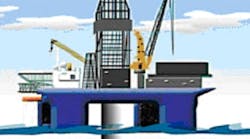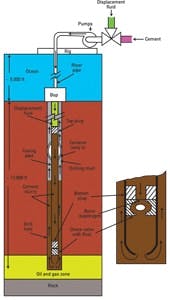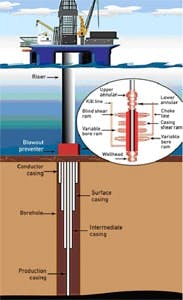This column is moderated by Béla Lipták, automation and safety consultant, who is also the editor of the Instrument and Automation Engineers’ Handbook (IAEH). If you would like to become a contributing author of the 5th edition or if you have an automation related question for this column, write to: [email protected]
Read Also: Automation Could Have Saved Fukushima and Automation Could Have Prevented Fukushima, 2
Closing serves to plug the casing pipe with a concrete plug strong enough to hold against the highest formation pressure. To control that, we must keep the plug pressure higher than that of the formation. Unfortunately, BP did not do that.
Blowout and the Methane "Kick"
A blowout occurs if the formation pressure (Pf) suddenly rises because the methane hydrate or methane ice (MI) in the formation developed a "kick." The MI crystal is a solid similar to ice, except that it traps large amounts of methane within its crystal structure. The extreme cold and crushing pressure (2200 PSIG at 5000 feet at the ocean bottom and about 8000 PSIG at the depth of the oil deposits at 15,000 feet) keeps this crystal in the solid state. If the pressure drops or the temperature rises to the point of phase transition (PhT), it triggers the MI to suddenly vaporize.
The temperature of both the continental and the oceanic crust increases with depth, reaching values in the range from about 200 °C (392 ºF) to 400 °C (752 ºF), and the rate of temperature rise is about 30 ºC (about 50 ºF) for every kilometer.
Each cubic foot of MI crystals explodes into 164 cubic feet of gas. Therefore, it is wise to avoid drilling through MI deposits and, if it is done accidentally, to keep the pressure inside the well above and the temperature below the PhT point. Naturally, to know where you are during this process requires measurements.
Now let us look at the sequence of events, which started with the cementing of the well. In this case, BP completed that only 20 hours before the temporary "killing" of the well started.
Cementing
Cementing of the well serves to position the production casing pipe firmly inside the drill hole and to seal the walls of the drill hole so that oil or gas can enter the pipe only from the bottom of the well, but not through the walls. The wellhead at the Deepwater Horizon well sat on the ocean floor, nearly a mile from the surface. The drill hole itself went another 13,000 feet into the rock.
Read Also: SEMS After Deepwater Horizon
Figure 1. The cementing process involves pumping cement, slurry and displacement fluid into the well.
When the drilling is over, the well is full of drilling mud that was circulating during the drilling phase. As shown in Figure 1, the cementing process starts with lowering a steel pipe (casing) into the well. After that, the pumping of concrete and later, the pumping of cement slurry takes place, followed by the pumping of displacement fluid. During this operation two plugs, called bottom or wiper and top or cementing plugs, are inserted, as shown in Figure 2. [See below]During cementing, first the bottom plug is inserted, and the pumped cement slurry breaks the burst diaphragm (rupture disk) in the bottom plug and, as it rises, it displaces the drilling mud, pushing it up and out of the annulus between the casing pipe and the drill hole.
Once the displacing of the drilling mud is done and the annulus is full the cement slurry, the top plug is inserted, and it is pushed down by a displacement fluid that is pumped in behind it. When it reaches the bottom plug, the job is done, and the check valve below the bottom float prevents flow reversal (see detail on the right of the Figure 2).
In case of the BP accident, the check valve failed, and because the methane pressure in the rock formation exceeded the pressure inside the badly cemented annulus (the cement had cracks in it), the methane broke through, and the "blowout" of methane and oil followed.
The amount of time it takes for the cement to harden is called thickening time or "pumpability time." For setting and temporarily sealing wells at depths such as that of the BP well, under high temperature and pressure, strong cements are required, and the low- density cement slurry was not of sufficient quality and probably contributed to the BP accident. The cement was of low density because the contractor mixed in nitrogen to make the cement slurry more "elastic" and set faster.
Sealing the Wells
Shortly after the cementing was done, workers started sealing the well. This is done by pumping the "killing fluid" (a concrete mixture) down into the casing pipe, through the kill line shown in Figure 2. In this phase of the operation, until the concrete sets, the maintaining of the killing fluid pressure high enough to always exceed the formation pressure is essential, and this pressure can be controlled by keeping the concrete mix density high enough to provide the required hydrostatic pressure that prevents the blowout.
Figure 2: The main components of the drilling process, including the blowout preventer and the "kill line" below.
Instead, the following occurred at BP. Cementing was completed on April 19, 2010. The next day, on April 20 at 7 a.m., BP cancelled the test required to determine if the bonding of the cement was strong enough in the annulus, nor did engineers check the blow-out preventer (BOP) and just started sealing the well. They were in a hurry because the crew performing the sealing was to lave on an 11:15 a.m. flight.Between that time and the time of the blowout some 10 hours passed, during which time no corrective action was taken. After that, at around 9:40 p.m., a jolt was felt on the bridge followed by the rig shaking and alarms being activated, because the most dangerous level of combustible gas intrusion was detected. Yet electricity was not turned off and at 9:45 p.m. the gas exploded, and oil and concrete was blown of the well onto the deck and ignited. The rest we know.
So what happened? Obviously, the cement plug was not strong enough to stop the oil and gas from blowing out. So was that predictable and would automation have prevented it? The answer is a definite yes! Testing indicated the presence of a leak somewhere in the well. In spite of that, because everyone was in a hurry, BP decided to use a low-density cement plug and seawater behind it, instead of keeping the concrete mix density high enough to provide the required hydrostatic pressure that would have prevented the blowout.
If this operation were automated, the balancing pressure required to exceed the formation pressure would have been automatically calculated and applied. In other words, the control system would have kept the hydrostatic pressure high enough to prevent the gas from entering the well and would have prevented the use of low-density cement or sealing fluid.
Therefore, in order to protect against the repetition of the BP accident, it is essential to have reliable (redundant) sensors and fully automatic response to unsafe conditions and mistakes made by either untrained operators or by ones willing to cut corners. This requires using reliable sensors and "smart annunciators," which not only inform the operators about the existence of unsafe conditions, but either gives them instructions on what to do about them or, preferably, automatically does it.
In case of the BP accident, this would have not only prevented the application of the weak concrete plug that allowed the blowout, but would have stopped also the whole operation until the blowout preventers were tested and would have automatically disengaged the rig from the well as soon as fire was detected.







